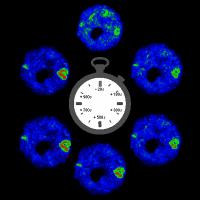
Watching genes turn on: Multiphoton microscopy images of living cells show the transcriptional activation of heat shock loci in real time. The molecular machinery behind gene transcription -- the intricate transfer of information from a segment of DNA to a corresponding strand of messenger RNA -- isn't stationed in special "transcription factories" within a cell nucleus, according to Cornell researchers. Instead, the enzyme RNA polymerase II (Pol II) and other key molecules can assemble at the site of an activated gene, regardless of the gene's position.
The findings, published in the Dec. 28, 2007, issue of the journal Molecular Cell, are the result of an ongoing collaboration between the laboratories of John T. Lis, the Barbara McClintock Professor of Molecular Biology and Genetics, and Watt W. Webb, professor of applied physics and the S.B. Eckert Professor in Engineering. Jie Yao, the paper's lead author, recently finished his Ph.D. at Cornell under Webb.
Using multiphoton microscopy, a technique developed by Webb that allows high-precision 3D imaging in living cells, the researchers observed polytene chromosomes -- giant, multistranded chromosomes in the salivary gland tissue of fruit flies that have hundreds of sets of the genome instead of the usual two sets in conventional cells.
They activated heat shock genes, which protect cells from sudden rises in temperature, and watched them in real time as they began to be transcribed. The researchers also tagged Pol II with a fluorescent marker to track its movements within the nucleus.
While some reports have suggested that activated genes move to a specific nuclear location for transcription, the Cornell research supports the traditional view that gene activation is not dependent on movement to special locations, or so-called "transcription factories," said Lis.
"You see the genes decondense and fill up with polymerase, but they're not moving anywhere -- they don't collect in a single place," he said. Instead, the transcription machinery assembles at the called-upon locus, regardless of its position in the nucleus.
To test the generality of the findings beyond polytene nuclei to common (but much smaller and more difficult to test) diploid cells, the researchers used a technique called fluorescence in situ hybridization, which allowed them to detect the location of specific DNA sequences along a chromosome in fixed cells.
Looking at the location of co-regulated heat shock genes (genes that are transcribed simultaneously), they found that co-regulated pairs that occupied distinct sites before heat shock were no closer together after heat shock. As in the polytene chromosomes, the genes did not move to a single site for transcription.
And using fluorescence recovery after photobleaching -- another method engineered by Webb -- the researchers found that over time Pol II began to recycle itself within newly formed "compartments" around the activated gene.
"At some point you accumulate enough polymerase that it feeds back, so in a sense you've created a factory de novo" said Lis. "This is, to our knowledge, the first demonstration of Pol II recycling at a specific gene in vivo."
Lis and colleagues are now looking at other molecules involved in transcription to see if they behave similarly. "We're hoping to develop new ways to really see, in vivo, how gene regulation works mechanistically," he said.
Source : Cornell University Communications
 Print Article
Print Article Mail to a Friend
Mail to a Friend
